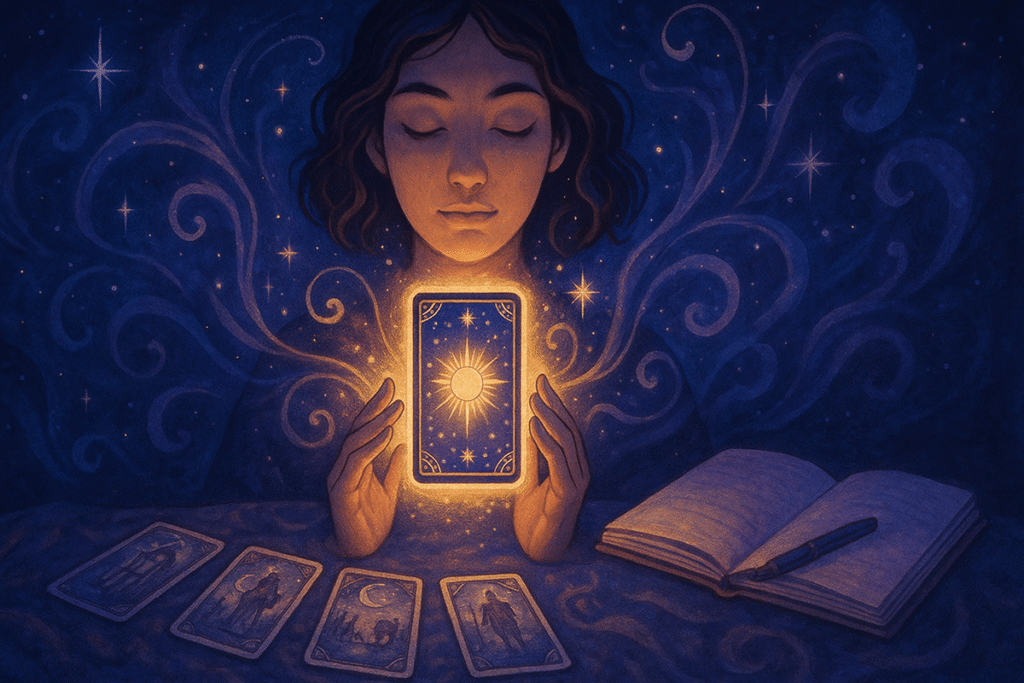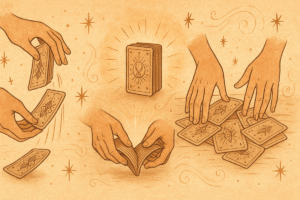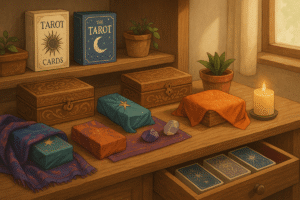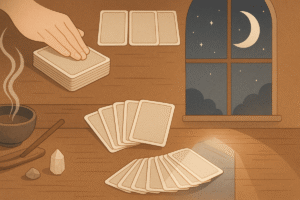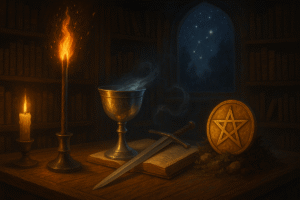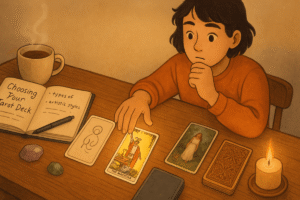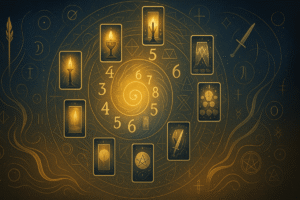Table of Contents
There’s something that happens when you sit down with a tarot deck for the first time. Maybe you shuffle the cards, lay them out in a simple three-card spread, and then… you freeze. Your hand hovers over the guidebook because you’re not sure what you’re supposed to be seeing. Everyone talks about intuitive reading like it’s some mystical gift you either have or don’t have, but that’s not really what’s happening at all.
Intuition in tarot isn’t about psychic powers or supernatural insight. It’s about learning to recognize the patterns your mind is already picking up on, the associations you’ve built over a lifetime, and the subtle feelings that emerge when you look at an image. When someone says they’re reading intuitively, what they’re actually doing is allowing their subconscious knowledge to surface. That’s a skill you can develop, not a talent you’re born with.
This guide is going to walk you through what intuition really means in the context of tarot, and more importantly, how you can build confidence in your own insights. We’ll explore practical exercises you can start using today, whether you’re a complete beginner or someone who’s been reading for years but still feels stuck relying on guidebooks.
Understanding What Intuition Actually Means
The word “intuition” gets thrown around a lot in tarot circles, often in ways that make it sound mysterious or inaccessible. But if we strip away the mystique, intuition is really just your brain’s ability to process information quickly, drawing on memories, emotions, and patterns you’ve absorbed without consciously cataloging them.
Think about how you can walk into a room and immediately sense tension, even if no one has said a word. You’re picking up on body language, tone, facial expressions, things you’ve learned to read over years of social interaction. That’s intuition at work. Your conscious mind hasn’t analyzed each detail, but your subconscious has already done the math.
Tarot works similarly. The cards are rich with symbolism, color, figures, landscapes, and objects. When you look at a card, your mind starts making connections based on your personal history and cultural knowledge. Maybe the water in the background reminds you of a childhood memory. Perhaps the figure’s posture echoes someone you know. These aren’t random thoughts; they’re your mind offering you information.
The challenge is that we’ve been trained to distrust these initial impressions. We want the “correct” answer, the official meaning, the interpretation that proves we’re doing it right. But tarot isn’t a test with a single answer key. It’s more like looking at a piece of art and describing what you see. Two people can look at the same painting and have entirely different yet equally valid experiences.
When you’re reading tarot, your intuition is the bridge between the card’s imagery and your personal understanding. It’s not about receiving messages from the universe or channeling some external force. It’s about trusting that your subconscious mind is capable of finding meaning in symbols, just as it does every day when you read facial expressions, interpret dreams, or understand metaphors in conversation.
The Subconscious Pattern Recognition Engine
Your brain is constantly scanning for patterns. It’s how you learned to read, recognize faces, and predict whether someone is about to laugh or cry. This pattern recognition happens so quickly and automatically that you’re often unaware it’s occurring at all.
Tarot imagery taps directly into this system. The Rider-Waite-Smith deck, which is what most people learn with, was designed with specific psychological and symbolic elements. Pamela Colman Smith, the artist who created the images, drew on a rich tapestry of esoteric traditions, yes, but also on universal human experiences. Figures in moments of despair, triumph, contemplation, or action. These are scenes your brain already knows how to read.
When you look at the Three of Swords, with its heart pierced by blades against a stormy sky, you don’t need a guidebook to tell you it’s about pain. Your pattern recognition system sees the imagery and connects it to experiences of heartbreak, betrayal, or difficult truths. That immediate gut feeling? That’s not random. It’s your subconscious drawing on everything it knows about how pain is represented in art, literature, and life.
The same process happens with more complex cards. The Tower shows a structure being struck by lightning, people falling from it. Even without studying tarot, most people feel an immediate sense of disruption, sudden change, or things falling apart. That’s pattern recognition. Your brain has seen countless stories about foundations crumbling and dramatic upheavals. It knows this territory.
Building intuitive reading skills means learning to trust these initial impressions rather than immediately second-guessing them. It also means understanding that your patterns are personal. Maybe someone else sees the Tower and thinks of liberation, of finally escaping a confining situation. Neither interpretation is wrong. They’re both valid responses to the same symbolic image, filtered through different life experiences.
Personal Associations Matter More Than You Think
Here’s something that might surprise you. The “traditional” meanings of tarot cards that you find in guidebooks? They’re not ancient, unchanging truths. They’re interpretations that have evolved over time, influenced by specific cultural contexts and individual readers who became influential in the tarot community.
Arthur Edward Waite had his ideas about what each card meant. Aleister Crowley had different ones. Rachel Pollack brought another perspective. Your favorite contemporary tarot author has their own spin. All of these interpretations are valuable, but none of them are more correct than what the cards mean to you personally.
This is actually liberating once you accept it. It means you can build your own relationship with each card based on your experiences, your cultural background, your memories, and your associations. When you see the Empress, maybe you think of your grandmother’s garden. That’s a valid connection. Perhaps the Four of Cups reminds you of a specific moment when you felt stuck in indecision. That personal memory is worth paying attention to.
These personal associations are often where the most meaningful insights come from in a reading. They’re specific to you, which means they carry emotional weight and relevance that a generic interpretation from a book might not capture. When you’re reading for yourself, these connections are gold. When you’re reading for someone else, learning to share what you see in the cards while leaving space for their associations creates a collaborative, exploratory experience.
I think sometimes people worry that relying on personal associations means they’re “doing it wrong” or ignoring the card’s real meaning. But cards don’t have one real meaning. They have layers of possible meanings, and your job as a reader is to explore which layers feel most relevant in the moment. Your personal associations are one of those layers, and often the most immediately accessible one.
Practical Exercise One: Describe Before You Define
This is the exercise I recommend to every beginner who feels stuck in guidebook dependency. It’s simple but surprisingly powerful. When you draw a card, before you do anything else, describe what you see out loud. Not what the card means. Just what’s literally in the image.
Take the Six of Cups, for example. You might say: “I see two figures, maybe children, in what looks like a village or town square. There are six cups, and they have flowers in them. One figure is handing a cup to the other. The buildings behind them look older, maybe medieval. The colors are soft, mostly yellow and pink. Everyone looks peaceful.”
That’s it. No interpretation yet. Just observation. What this does is force your conscious mind to actually look at the card instead of immediately jumping to what you think it’s supposed to mean. It slows you down. And in that slower space, something interesting happens. Your subconscious starts making connections.
As you describe the flowers in the cups, you might remember getting flowers as a child. As you mention the older buildings, you might feel a sense of nostalgia or history. The act of one figure giving something to another might bring up thoughts about gifts, generosity, or childhood friendships. These aren’t random thoughts. They’re your intuition working, offering you threads to pull on.
After you’ve described what you see, then you can ask yourself: “What does this scene make me think of? What feeling does it evoke?” Often, you’ll find that your description has already led you to an interpretation that feels more personal and relevant than what you’d find in a book. Perhaps you’ve been thinking about reconnecting with an old friend, and suddenly the Six of Cups feels like it’s speaking directly to that situation.
This exercise works because it removes the pressure to be right. You’re just describing. Anyone can describe what they see in a picture. There’s no wrong way to do it. But in that act of description, you’re giving your intuition permission to speak up.
Practical Exercise Two: The Feelings Journal
This one requires a bit more time, but it’s worth it. Keep a journal specifically for tarot practice. Each day, or whenever you feel like practicing, draw a single card. Instead of looking up its meaning, write down every feeling and thought that comes up when you look at it.
This isn’t about crafting perfect interpretations. It’s stream of consciousness stuff. “This card makes me feel uneasy. The red color is aggressive. The figure looks trapped. Why are there so many swords? This reminds me of that argument I had last week. I feel defensive looking at this.”
Whatever comes up, write it down. Don’t censor yourself. Don’t worry about whether your thoughts match the traditional meaning of the card. Just capture your raw, unfiltered response. Do this for a week or two without looking up any meanings. Let the cards speak to you directly, without the filter of someone else’s interpretation.
Then, after you’ve built up a collection of these entries, you can go back and read some traditional interpretations if you want. You’ll probably find that many of your instinctive responses align with established meanings. But you’ll also find places where your interpretation is unique, shaped by your specific context and experiences. Both discoveries are valuable. The alignments build confidence that you’re picking up on the cards’ symbolic language. The differences remind you that tarot is a personal practice, not a memorization test.
The feelings journal does something else too. It creates a record of your developing relationship with the deck. Over time, you’ll notice patterns in how you respond to certain cards or symbols. Maybe you consistently feel hopeful when you see cards with stars or water. Perhaps figures facing left make you think about the past while figures facing right make you think about moving forward. These patterns are your personal symbolic vocabulary developing. That’s intuition being built, one entry at a time.
Building Confidence Through Repetition
There’s no way around it. Building trust in your intuition takes practice. It’s like learning to play an instrument or speak a new language. At first, you’re hyperaware of every move, constantly checking whether you’re doing it correctly. Eventually, with enough repetition, it becomes more natural. You stop thinking about it quite so much.
The key is consistent, low-pressure practice. Pull a card every morning and spend two minutes with it. Not trying to do a complex reading, just noticing what comes up. What’s your first impression? What does the energy of the card feel like today? Some days you’ll feel very connected to the card. Other days it might feel opaque or confusing. Both experiences are fine. Both are teaching you something about how your intuitive process works.
It helps to remove the stakes from practice. You’re not trying to predict the future or make a major life decision. You’re just exploring the cards, building familiarity, training your pattern recognition system. Think of it like those exercises where artists draw the same object over and over from different angles. You’re developing observational skills and hand-eye coordination, except in this case, it’s developing symbolic literacy and intuition-consciousness coordination.
Over time, something shifts. You’ll notice that you reach for the guidebook less often. You’ll find yourself saying things like “I’m getting a feeling that…” or “When I look at this card, what comes to mind is…” And you’ll trust those statements enough to voice them, even if you’re not entirely sure where they came from. That’s intuition becoming integrated into your reading practice.
What Intuition Isn’t
It might be helpful to clarify what we’re not talking about here. Intuitive reading doesn’t mean you’re receiving psychic information or that the cards themselves are sending you messages. We’re not in the realm of fortune telling or supernatural communication. That’s important to understand, not just for clarity, but because that mindset can actually interfere with developing genuine intuitive skills.
When you approach tarot as if it’s a mystical oracle providing definitive answers about what will happen, you put pressure on yourself to find the one correct interpretation. That pressure silences the subtle, exploratory voice of intuition. You become focused on being right rather than being curious.
Intuition is also not the same as making things up or projecting whatever you want onto the cards. There’s a difference between personal interpretation and wishful thinking. If you draw a card that clearly depicts struggle or challenge, and you convince yourself it means everything is perfect, you’re not reading intuitively. You’re avoiding what the card is showing you.
True intuitive reading involves honesty. It means being willing to see what’s actually in the image, even if it’s uncomfortable. It means acknowledging your first impression, even if it’s not what you wanted to hear. The cards can serve as mirrors, reflecting back aspects of your situation or psyche that you might be avoiding. Intuition helps you see those reflections clearly, not distort them into something more palatable.
Integrating Intuition With Study
None of this means you should never read books about tarot or learn traditional interpretations. Study and intuition work best together, not in opposition. Learning about the symbolism embedded in the cards, understanding the structure of the deck, exploring different interpretative frameworks, all of this enriches your practice.
The difference is in the order of operations. When you encounter a card, give your intuition first crack at it. Notice what you see, what you feel, what associations arise. Then, if you want to, consult other sources. See how your intuitive hit compares to established meanings. Sometimes you’ll find they align perfectly. Other times, you’ll discover a nuance you missed. Occasionally, you’ll disagree entirely, and that’s a chance to explore why.
This approach keeps you active in the interpretive process rather than passive. You’re not just absorbing information from an authority. You’re in dialogue with the cards, with traditional knowledge, and with your own inner wisdom. That’s a much richer and more sustainable way to develop as a tarot reader.
Moving Forward With Trust
Learning to trust your intuition with tarot is really about learning to trust yourself. It’s about believing that your perceptions are valid, that your associations matter, that your subconscious mind is capable of making meaningful connections. That kind of self-trust extends beyond tarot into other areas of life, which is perhaps why so many people find tarot practice valuable even if they don’t believe in any supernatural elements.
Start small. Try the exercises outlined here. Describe what you see. Journal your feelings. Practice regularly without pressure. Notice when you have a strong gut reaction to a card and honor that response instead of immediately dismissing it. Over time, you’ll develop a relationship with your deck that feels personal and authentic rather than like you’re following someone else’s rulebook.
The beautiful thing about developing intuitive reading skills is that there’s no ceiling. You can always go deeper, notice more, make new connections. Every reading is an opportunity to explore the intersection between the card’s imagery and your inner landscape. What patterns are you recognizing today? What associations are emerging? What is this particular arrangement of symbols inviting you to reflect on?
These are the questions that turn tarot from a parlor trick or a memorization exercise into a genuine tool for self-exploration and contemplation. Your intuition is the key that unlocks that potential. You already have it. You just need to practice using it.
Frequently Asked Questions
How do I tell the difference between intuition and just wishful thinking?
Intuition typically feels like a calm, warm knowing that comes from your gut or heart, while wishful thinking tends to be loud, racing thoughts coming from your head that are driven by fear or what you want to happen. When you’re reading intuitively, pay attention to whether the message feels like genuine guidance or if it’s your ego trying to steer you toward a preferred outcome. Intuition often suggests things that challenge you to grow, while wishful thinking usually tells you exactly what you want to hear.
Do I need to memorize all the traditional card meanings before I can read intuitively?
No, you don’t need to memorize everything first. Understanding card meanings and developing intuition work best together, with intuition often flowing more naturally once you’ve practiced observing what’s actually in the cards. Start by describing what you see in the imagery and journaling your reactions, then layer in traditional meanings as you go. Your intuitive skills and knowledge of the cards will develop alongside each other through regular practice.
What should I do when my intuitive interpretation conflicts with the guidebook meaning?
Trust your intuitive response first, especially when reading for yourself. Even traditional meanings originated from someone’s intuition, and cards don’t have one fixed meaning but rather layers of possible interpretations. Your personal associations and the specific context of your reading often provide more relevant insights than generic interpretations. That said, if your interpretation consistently avoids uncomfortable truths, that might be wishful thinking rather than genuine intuition.
How long does it take to develop confidence in reading intuitively?
Building intuitive confidence is a gradual process that varies for each person. Like most skills, developing intuitive abilities requires consistent practice rather than natural talent. Start with low-pressure daily practice like pulling a single card each morning and spending just a few minutes noticing your reactions. Over weeks and months of regular practice, you’ll find yourself reaching for guidebooks less often and trusting your first impressions more naturally.

